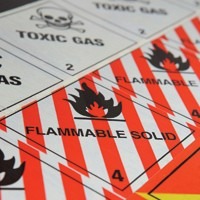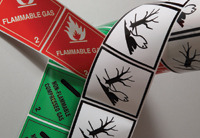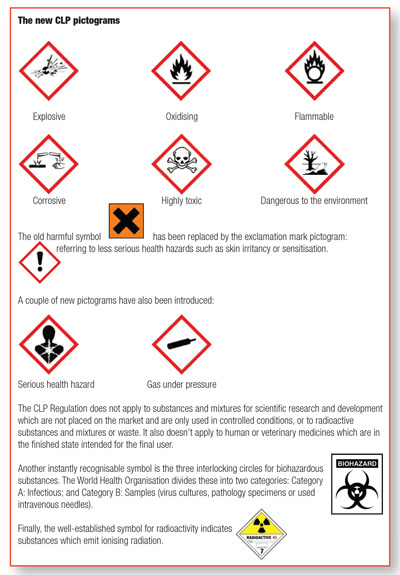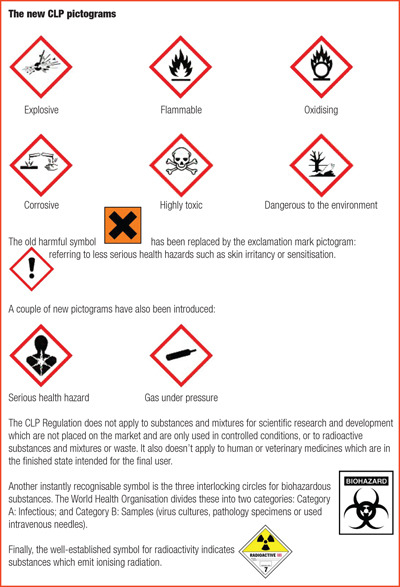Adhering to label legislation
9 Oct 2013 by Evoluted New Media
Working with potentially hazardous substances is an ever-present risk in a lab and a threat safeguarded against with specialist equipment, protective clothing and vigilant storage of chemicals in a properly maintained stockroom. Correct labelling of materials is crucial to careful handling. James Killerby spells out labelling legislation and what to look for when commissioning labels.
There is no national register of laboratory accidents but, anecdotally, most are caused by unexpected chemical reactions or by faulty or mishandled equipment. Mishaps generated by poor labelling go unrecorded but present a real danger. Chemical classification that highlights the intrinsic hazard of a substance is a fundamental part of the safe management, handling and use of chemicals and there is a legal obligation to do so accurately.
The legislation relating to correct labelling is complex, changes frequently and there are a wide variety of regulations and laws to take into consideration. There are, amazingly, 22 separate pieces of EU legislation which refer to the Dangerous Substances Directive and the Dangerous Preparations Directive, but universally recognised symbols are all that most of us need to know. The use of symbols to give immediate recognition of hazards provides scientists with a powerful tool against error.
 The new European CLP Regulation (Classification, Labelling and Packaging of Substances and Mixtures) for hazardous chemicals came into force in January 2009. Companies had until December 2010 to ensure that any labels for single substances were updated to the new regulations and, by June 2015, must do the same for mixtures.
The new European CLP Regulation (Classification, Labelling and Packaging of Substances and Mixtures) for hazardous chemicals came into force in January 2009. Companies had until December 2010 to ensure that any labels for single substances were updated to the new regulations and, by June 2015, must do the same for mixtures.
CLP has introduced new hazard pictograms in the shape of a red diamond with a white background, which will gradually replace the familiar old orange square hazard symbols which applied under the former CHIP (Chemicals Hazard Information and Packaging for Supply) legislation. Some substances and mixtures have already been labelled according to the new legislation, but the old pictograms can still legally appear on the market until June 2017.
CHIP is the law that has applied to suppliers of dangerous substances and mixtures for many years and will continue to be applied to mixtures until their reclassification to CLP on 1st June 2015.
The new pictograms are in line with the United Nations Globally Harmonised System (GHS) which uses the same, easily recognisable symbols but which might have a different colour border or background. The UN GHS is not a formal treaty, but instead is a non-legally binding international agreement which is underpinned by legislation in countries or trading blocks – hence CLP for the EU.
If you are transporting chemicals, there is even more legislation and legal documentation to keep abreast of with different regulations for road, rail, air and sea. Air transport is dealt with by the ICAO (International Civil Aviation Organisation) Technical Instructions for the Safe Transport of Dangerous Goods by Air. Anyone transporting dangerous goods by air should also check the IATA (International Air Transport Association) Dangerous Goods Regulations as these contain additional requirements.
Rail movement is covered by RID - Regulations concerning the International transport of Dangerous goods by rail (European Law). The transport of dangerous goods by sea is governed by the IMO (International Maritime Organisation) International Maritime Dangerous Goods Code (IMDG). The UK Maritime and Coastguard Agency website also contains useful information about dangerous goods, including a summary of the main changes to the IMDG Code Amendments.
International journeys by road through Europe are covered by the ADR Regulations (Accord européen relatif au transport international des marchandises Dangereuses par Route). Their main concern is to ensure identification of the hazardous substance being carried so that the emergency services know how to respond in the event of an accident.
REACH is a European Union regulation concerning the Registration, Evaluation, Authorisation and restriction of CHemicals. It is intended to make manufacturers and importers responsible for understanding and managing the risks associated with their use. It is also intended to allow the free movement of substanceson the EU market and to enhance innovation and competition within the EU chemicals industry.
Labelling substances in the lab can be challenging. Labels might be applied to containers holding materials heated to very high temperatures which are subsequently rapidly cooled and frozen. There is an adhesive product that will withstand that kind of extreme variation in temperature but it is more expensive as it’s a higher specification. There is no ‘one size fits all’ approach when it comes to chemical labelling and the specification that’s right for your circumstances can depend on many factors. Some adhesives, for example, don’t work on certain materials and some labels may need to last significantly longer than others.
The amount of solvents used in commercial adhesives is substantially lower than it has been in the past due to a government drive to reduce the risk to the environment, and they increasingly tend to be emulsion acrylics instead of being solvent-based.
Correct labelling of chemicals can create a safer environment and extra care in choosing the right ones could save your lab cost and reputation in the long term.

Top tips for safe labelling:
- Prepare the surface before you put your label on – make sure there is no moisture on it and your label will stick better.
- Stick down all the parts of your label carefully rather than just slapping it on.
- Don’t stick your label to anything else before the surface it was designed for.
- Ask yourself what the label’s lifecycle will be and what it will be exposed to. If you don’t know, it will be poorly specified and might not stick as well as it could have done.
Contact: www.hibiscus-plc.com Enquiries@hibiscus-plc.com













